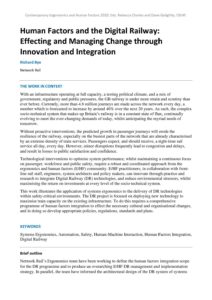| Document
|
Author Richard Bye |
| Abstract With an infrastructure operating at full capacity, a testing political climate, and a mix of government, regulatory and public pressures, the GB railway is under more strain and scrutiny than ever before. Currently, more than 4.8 million journeys are made across the network every day, a number which is forecasted to increase by around 40% over the next 20 years. As such, the complex sociotechnical system that makes up Britain’s railway is in a constant state of flux, continually evolving to meet the everchanging demands of today, whilst anticipating the myriad needs of tomorrow. Without proactive interventions, the predicted growth in passenger journeys will erode the resilience of the railway, especially on the busiest parts of the network that are already characterised by an extreme density of train services. Passengers expect, and should receive, a right-time rail service all day, every day. However, minor disruptions frequently lead to congestion and delays, and result in losses to public satisfaction and confidence. Technological interventions to optimise system performance, whilst maintaining a continuous focus on passenger, workforce and public safety, require a robust and coordinated approach from the ergonomics and human factors (human factors) community. Human factors practitioners, in collaboration with frontline rail staff, engineers, system architects and policy makers, can innovate through practice and research to integrate digital railway (DR) technologies, and reduce environmental stressors, whilst maximising the return on investments at every level of the sociotechnical system. This work illustrates the application of systems ergonomics to the delivery of DR technologies within safety-critical work environments. The DR project is focused on deploying new technology to maximise train capacity on the existing infrastructure. To do this requires a comprehensive programme of human factors integration to effect the necessary cultural and organisational changes, and in doing so develop appropriate policies, regulations, standards and plans. |

